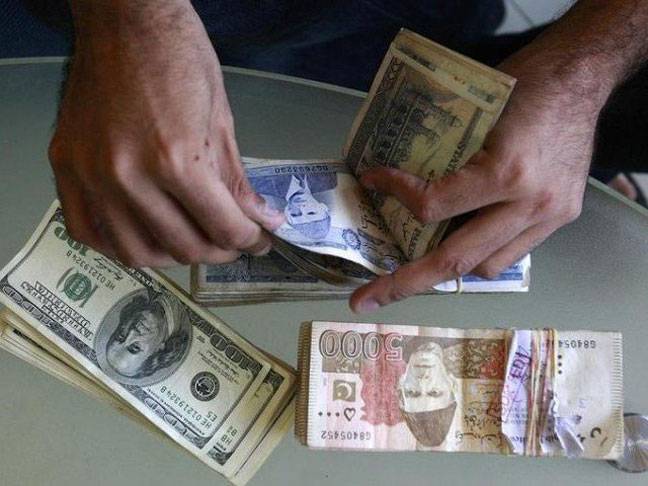LAHORE - Pakistani rupee on Tuesday slumped to an all-time low of 115.5 against the American dollar during intra-day trading in the interbank market, closing at Rs 114 as compared to Monday’s closing rate of Rs 110.5, in what appeared to be a currency devaluation by the central bank, the second such intervention in less than four months.
However, more pressure was seen in the open market where the local currency crashed by almost five percent to close at Rs 116.5 versus dollar on the back of deterioration of Pakistan’s external account.
Abid Qamar, spokesman for the State Bank of Pakistan (SBP), told Reuters the rupee plunge was a “market driven” event. However, foreign exchange traders say the central bank’s withdrawal of support for the rupee in daily market operations sent the currency lower.
Withdrawal of support would have the effect of devaluing the currency as the SBP is the most influential player in the thinly-traded local foreign exchange market and controls what is widely considered a managed float system.
In response to Reuters’ queries about the rupee’s decline on Tuesday, the central bank’s Qamar said it was triggered by “some payment pressures which are building within the market” and added that the central bank would be “observing the market where it is moving towards.”
Capital Economic, a macroeconomic research consultancy, said it expects the government to keep running down its foreign reserves until after the election in order to keep the rupee pegged. “Once the election is out of the way, however, more drastic action is likely,” Capital Economics said in a research note.
Financial market experts said that during fiscal year 2017-18, Pakistan posted current account deficit of $12.2 billion (4 percent of GDP) as compared to $2.6 billion (0.9 percent of GDP) in FY16. For the period of Jul-Feb 2018, the current account deficit has increased to $10.8 billion (3.5 percent of GDP) compared to $7.2 billion (2.4 percent of GDP) last year. As a result, Pakistan foreign exchange reserves with SBP also declined from $17.4 billion in January 2017 to $12.1 billion which is equivalent to 2.5 months of import cover.
The historical plunge of rupee created panic in forex markets in other parts of the country, including Lahore, creating artificial shortage of greenback. In the provincial capital of Punjab, almost all major currency dealers were refusing to exchange dollar against local currency mainly due to fear of further hike in dollar rate.
Lahore’s currency dealers said even registered exchange companies and licence holders were refusing to sell dollar not due to shortage of greenback, but owing to the speculation of greenback going to further high of Rs 120 per dollar.
Money market experts said the central bank had devalued rupee by around five percent in December 2017. In four months rupee is down by nine percent against dollar after remaining stable for almost 28 months. During the last 10 years, rupee has devalued annually by five percent.
The International Monetary Fund (IMF), in its recently published report, has also stated that Pakistani rupee is still overvalued by 10 percent and expects the full year current account deficit for FY18 at $15.7 billion (5 percent of GDP).
The financial market expert at Topline Securities, Fahad Qasim, observed rupee lost its value earlier than expectations as market was expecting that this weakening may take place in caretaker government setup in June 2018.
The currency dealers and financial experts said rupee has been tumbling in an apparent devaluation by the central bank itself, fearing the local currency is going to depreciate further to Rs 120 against dollar.
Noted economist Dr Salman Shah said if the currency is kept strong by artificial means, these benefits are transitory and unsustainable. The policy of controlling rupee artificially is difficult even for massive trade-surplus countries to pursue their currency indefinitely. He said overvalued exchange rate discouraged exports, encouraged imports and kept the rupee cost of foreign debt servicing high.
Importers are of the view that the central bank’s withdrawal of support for the rupee in daily market operations caused the plunge of the currency.
Another prominent economist, Dr Ashfaq Hassan Khan, supported depreciation of rupee to its fair value to revive exports and narrow down the trade and current account deficits. He said the local currency is overvalued, hurting exports which become more expensive.
Rice Exporters Association Pakistan Chairman Samee Ullah Chaudhry said the central bank kept rupee stable artificially for four years, compared to 1.5 percent and 0.5 percent depreciation of Indian and Sri Lankan currency, respectively, against US dollar. At a time when pro-export measures have failed, Pak rupee needs to be depreciated to gain its actual value to help trade and current account positions, he said.
The REAP chairman said it is worrying that Pakistan’s trade deficit is increasing. Given that exporters’ tax refunds are stuck with the government, the SBP had no choice but to make the rupee weaker to help the economy.
Samee Ullah Chaudhry welcomed the State Bank’s stance of market-based devaluation, which was long-awaited. The exchange rate should be based on demand and supply of dollars in the interbank market, he contended. He said it would be more prudent to allow the currency to slide in an orderly fashion towards a fairer valuation without any further intervention.
Lahore Chamber of Commerce & Industry’s Khawaja Khawar Rashid urged the State Bank to control rapid surge in dollar price through strict measures otherwise rupee devaluation would give a big blow to the economy.
The apparent devaluation comes at a time when country’s nearly $300 billion economy is showing signs of vulnerability despite surging growth rates.
US dollar price against rupee was Rs 4.76 in 60s, Rs 59.30 in 2005 and touched the highest level during the current financial year.
Rupee hits record high of 115.5 against $






